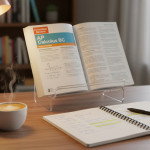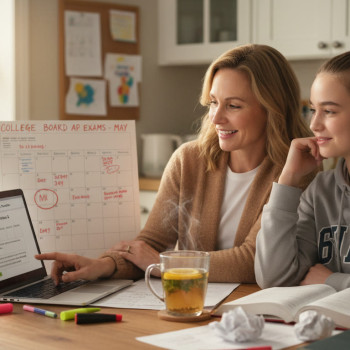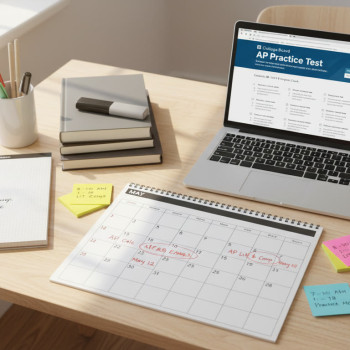Why Mock Presentation Day Matters More Than You Think
Mock Presentation Day isn’t just a run-through. It’s the rehearsal that sharpens your argument, steadies your voice, and reveals the small gaps that can undermine great research. For AP Seminar and AP Research students, presentation day is the public culmination of months of reading, synthesizing, and writing. Treating a mock as an afterthought is a missed opportunity—used well, it becomes the difference between a perfunctory delivery and a compelling, memorable defense of your work.

What Teachers and College Board Are Listening For
Understanding what evaluators look for helps you target practice time where it counts. AP Seminar and AP Research presentations are assessed on clarity of argument, evidence selection, methodological transparency (for Research), structure, and your ability to respond to questions with poise and precision. It’s not about theatrical flair—although confidence helps—it’s about demonstrating mastery of your inquiry and the integrity of your reasoning.
Core Elements to Highlight
- Clear research question or thesis—concise and researchable.
- Logical structure—signpost what you’ll cover and stick to it.
- Evidence and sources—explain why you chose them and how they support your claims.
- Methodology and limitations—for AP Research, be explicit about methods, sampling, and boundaries.
- Engaging visuals—supplement, don’t replace, your spoken argument.
- Oral defense readiness—practice answering questions with specific references to your work.
How to Set Up a Realistic Mock Presentation Day
Design your mock to mirror the actual conditions as closely as possible. That means timing, technology, panel composition, and even the nervous energy. A realistic mock creates pressure—and pressure reveals truth. Here’s a step-by-step blueprint you can follow with your team or with classmates.
Pre-Mock Checklist
- Reserve a room that can accommodate your audience and tech needs.
- Print or distribute your presentation slides and individual research report ahead of time.
- Assign roles: presenter(s), timekeeper, panelists (teachers or peers), note-taker for feedback.
- Decide on timing: 6–8 minutes for AP Seminar individual presentations, 6–8 minutes for Seminar team multimedia (varies by task), and 15–20 minutes total for AP Research presentations.
- Test all technology (projector, speakers, captions, laptop compatibility) at least 15 minutes before the session.
During the Mock
- Start on time—punctuality is part of professionalism.
- Begin with a 30–45 second hook that frames your research question and why it matters.
- Use signposting language: “First, I’ll outline… Next, I’ll show… Finally…”
- Keep slides uncluttered: aim for one main idea per slide and readable fonts.
- For AP Research, ensure a clear sequence: research question, literature, method, results, implications, limitations.
- Conclude with a concise take-away and prepared transitions to the oral defense.
Grading Guide: Self-Rubric for Mock Feedback
To get the most value from a mock, give focused feedback that maps onto scores you’d expect from your teacher. Below is a compact rubric you can use to grade performances and identify specific improvement areas.
| Criteria | Excellent (3) | Satisfactory (2) | Needs Work (1) |
|---|---|---|---|
| Clarity of Research Question | Clear, researchable, and compelling | Understandable but could be more focused | Unclear or too broad |
| Use of Evidence | Selective, relevant, well-integrated | Relevant but occasional weak connections | Unsupported claims or overreliance on a single source |
| Structure and Flow | Logical, smooth transitions, strong signposting | Mostly logical with a few jumps | Disjointed or difficult to follow |
| Delivery | Confident, clear voice, appropriate pacing | Nervous but understandable, occasional pace issues | Mumbled, too fast/slow, distracting |
| Oral Defense | Direct answers, cites evidence, acknowledges limits | Answerable with some hesitation or vagueness | Unable to justify claims or answer follow-ups |
How to Use the Rubric
After the mock, total the scores and convert them into actionable items: one thing to keep, two things to improve, and one thing to remove or simplify. Try to be specific: instead of “improve delivery,” say “slow down after each statistic for two seconds and look at the panel.” Specificity makes practice measurable and progress visible.
Rehearsal Techniques That Work
Practice isn’t one-dimensional. You need content rehearsal, delivery rehearsal, and defense rehearsal—the latter often forgotten but crucial. Mix solo drills with group sessions to sharpen different skills.
Solo Drills
- Record one-minute micro-summaries of your work—this improves clarity and your “elevator pitch.”
- Shadow-practice: speak while watching yourself on video to catch mannerisms and pacing.
- Timed runs: practice with exact time limits and a visible timer.
Group Rehearsals
- Peer panel Q&A: have classmates ask difficult, skeptical, and clarifying questions.
- Switch roles: let someone else present your slides to see where the narrative is fragile.
- Audience feedback rounds: each listener gives one positive and one improvement point.
Common Presentation Pitfalls and How to Avoid Them
Even the best research can be undermined by small, fixable mistakes. Here are the most frequent traps and practical fixes.
Pitfall: Overloaded Slides
Fix: Use slides as cues, not scripts. If a slide has more than 40 words, break it up or convert text into a visual or short bullet.
Pitfall: Too Much Jargon
Fix: Explain technical terms briefly the first time you use them—assume an intelligent but not specialist audience. Simple metaphors often help.
Pitfall: Weak Defense Responses
Fix: Prepare three stock responses: one for methodological critique, one for evidence gaps, and one for implications. Practice them until they sound natural, not canned.
Day-Of Mock Logistics: A Practical Timeline
Use this timeline to run an efficient mock day that includes setup, presentations, and meaningful feedback without running overtime.
- 60 minutes before: Set up room, test A/V, print rubrics.
- 30 minutes before: Panelists arrive, quick brief on scoring and expectations.
- Start: Welcome and 5-minute orientation for audience.
- Presentations: Follow scheduled order, each with exact timing (e.g., 8 min presentation + 4 min Q&A).
- After each presentation: 5–7 minutes of panel feedback using the rubric.
- Final 15 minutes: Group reflection, action items, and next steps.
Examples: What Strong Openings and Conclusions Sound Like
How you begin and close matters. Here are quick templates that you can adapt to your content—short, memorable, and linked to evidence.
Opening Template
“In 2018, X percent of [population] experienced [phenomenon], but we still don’t know [research gap]. My question asks whether [specific intervention or variable] changes [measurable outcome]. Today I’ll show you the evidence I gathered and why it matters for [real-world application].”
Conclusion Template
“To sum up: my analysis suggests [main finding], supported by [two strongest pieces of evidence]. While limitations include [brief limitation], this points to [practical implication]. I welcome your questions about methods, evidence, or next steps.”
How to Make Visuals That Strengthen, Not Distract
Good visuals focus attention. Think clarity, contrast, and purpose. A slide with a single chart and one takeaway line is far more powerful than a slide crammed with dense text.
- Use clear labels and avoid tiny fonts.
- Highlight the takeaway directly on a chart with a caption like: “Key Point: X increased by 40%.”
- Use color sparingly to emphasize—two or three colors at most.
Using Peer Feedback to Level Up
A great mock is not just a test—it’s a collaborative improvement workshop. Create feedback prompts that push specific improvements rather than vague praise.
Feedback Prompts
- “What’s one sentence that could make the research question clearer?”
- “Which slide needed a clearer takeaway and why?”
- “What question would you ask the presenter if you were an evaluator?”
Integrating Professional Support When It Helps
Sometimes an external perspective accelerates progress. Services like Sparkl provide 1-on-1 guidance, tailored study plans, expert tutors, and AI-driven insights that fit naturally into a mock preparation routine. If you’re juggling multiple AP tasks or need focused help on presentation delivery, targeted tutoring sessions can hone weak spots quickly—especially on oral defense strategies and slide design.
Checklist: The Final 48-Hour Prep
Two days out, your job is to simplify, not to add more content. Run this checklist and you’ll show up sharp and ready.
- Finalize slides: one idea per slide, max 10–12 slides for a short presentation.
- Print single-page speaker notes and a one-paragraph handout for the panel.
- Run a full timed rehearsal with a visible timer and a peer panel.
- Prepare three short defense answers for anticipated tough questions.
- Pack backups: USB, PDF copy emailed to yourself, charger, and printed rubric.
- Get rest: a well-rested voice and mind outperform last-minute cramming.
Real-World Context: How Presentation Skills Translate Beyond AP
These presentations aren’t just a test—they’re practice for college seminars, research conferences, internships, and future job interviews. Learning to tell a clear research story and answer questions calmly demonstrates intellectual maturity. The skills you sharpen here—evidence synthesis, audience awareness, structured argument—are the same skills that professors and employers value.
Post-Mock: Turning Feedback into a 2-Week Improvement Plan
Mock feedback is only useful if it becomes action. Convert comments into a two-week plan that targets the weakest 20% of your performance, where you can get the most improvement.
| Week | Focus | Daily Actions | Measure of Success |
|---|---|---|---|
| Week 1 | Argument Clarity | Rewrite introduction, 3 timed recitations, refine slides | Introduction under 45 seconds and panel understands Q |
| Week 2 | Defense & Delivery | Daily Q&A drills, record and review video, practice breathing | Confident responses to 8/10 peer questions |
Final Thought: Make the Mock Day Yours
Mock Presentation Day is your chance to try on the version of yourself who can present calmly, think on their feet, and defend complex ideas with grace. Treat it as a workshop rather than an exam. Use the mock to experiment: try different openings, refine visuals, and test the language you use during defenses. With deliberate practice and targeted feedback—whether from peers, teachers, or tailored support like Sparkl’s tutoring—you’ll convert nervous energy into focused confidence. Walk into your real presentation knowing you’ve already performed under pressure—and that makes all the difference.

Quick Resources to Keep in Your Back Pocket
- One-paragraph summary of your research question and findings.
- One-minute “elevator pitch” for introductions.
- Three prepared oral defense answers (methodological, evidence, implication).
- Printed rubric copy for audience scoring.
Mock Presentation Day is a rehearsal for clarity, and clarity is practice. Start early, rehearse deliberately, and use every mock as a calibration tool. When your mock feels polished, your actual presentation becomes an opportunity to showcase your intellectual voice, not just to pass a test but to make an argument that matters.
Good luck—present boldly, defend thoughtfully, and remember: your research is worth being heard.
























No Comments
Leave a comment Cancel